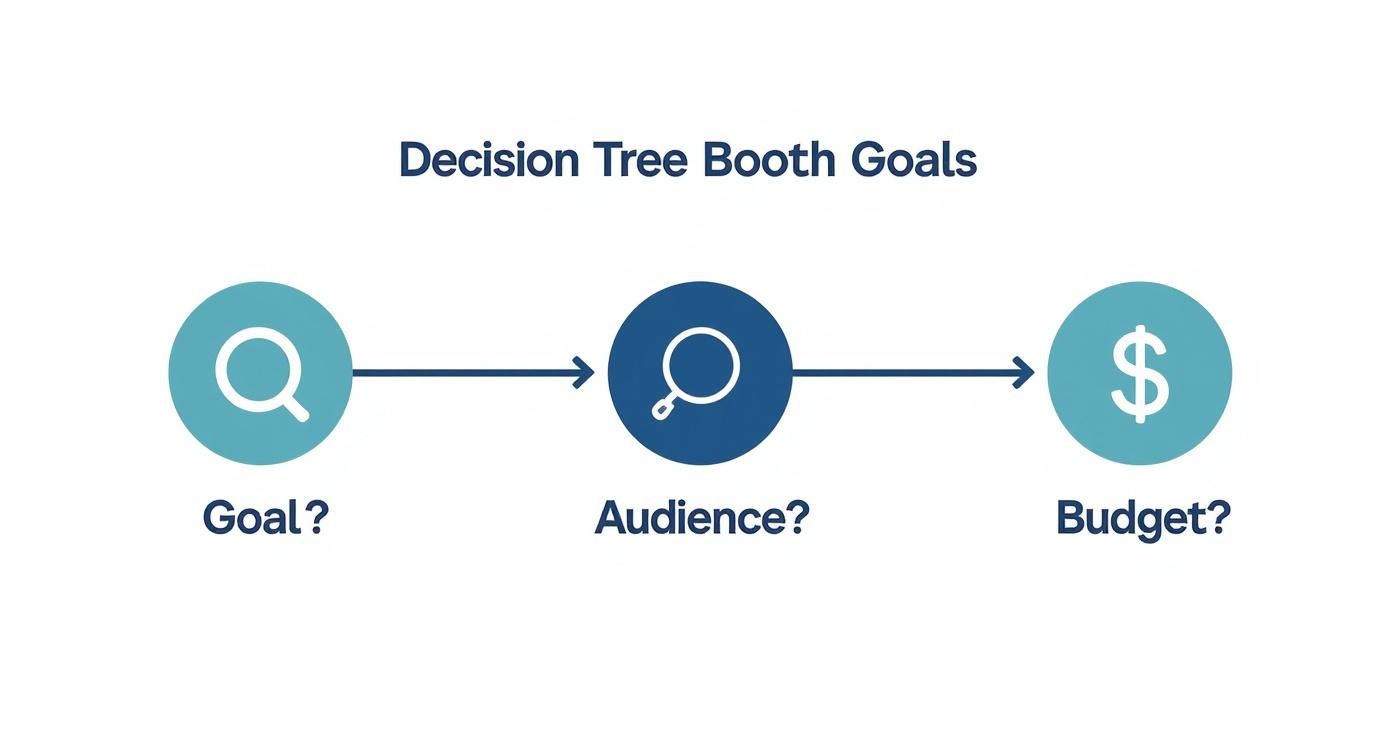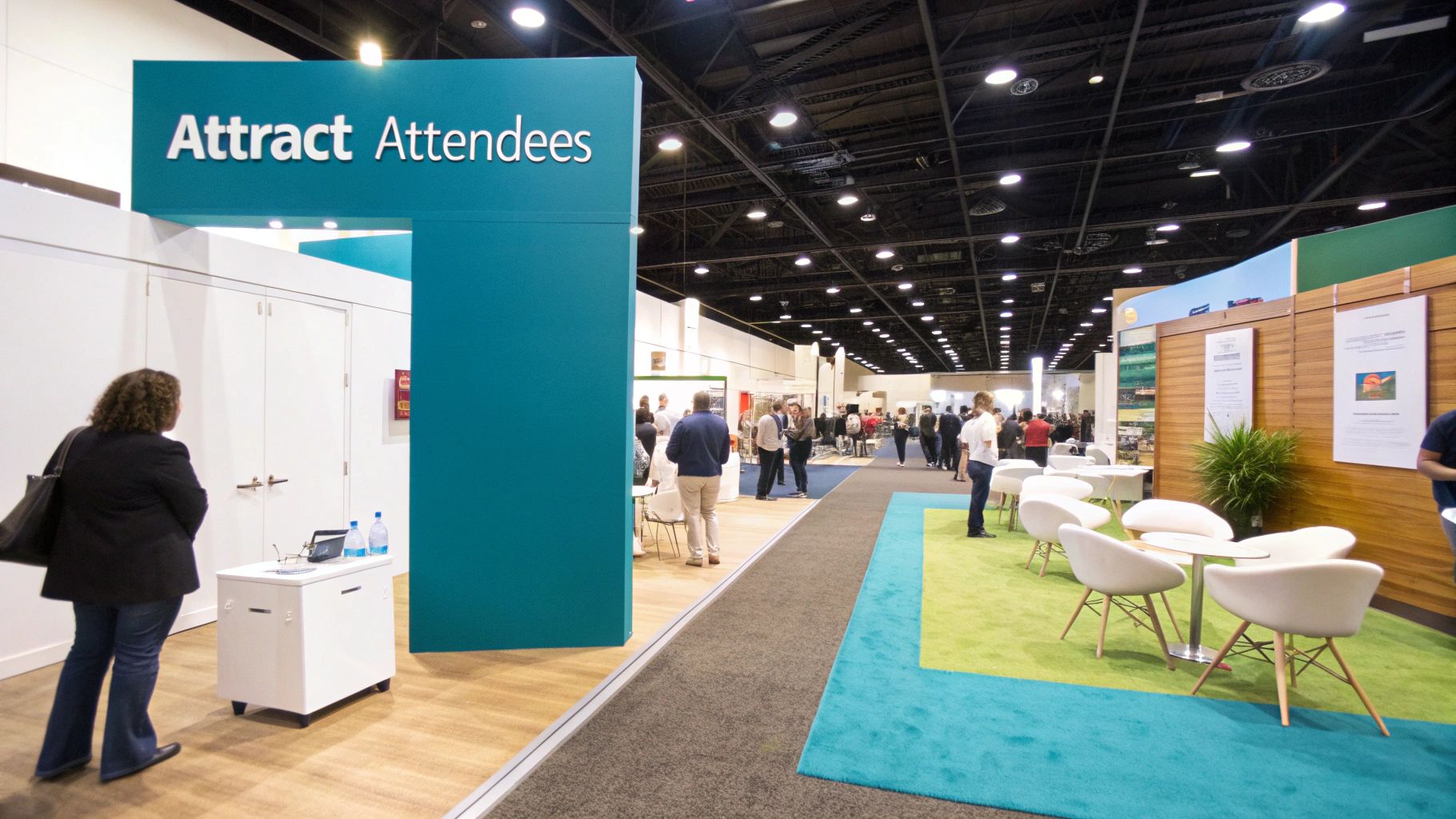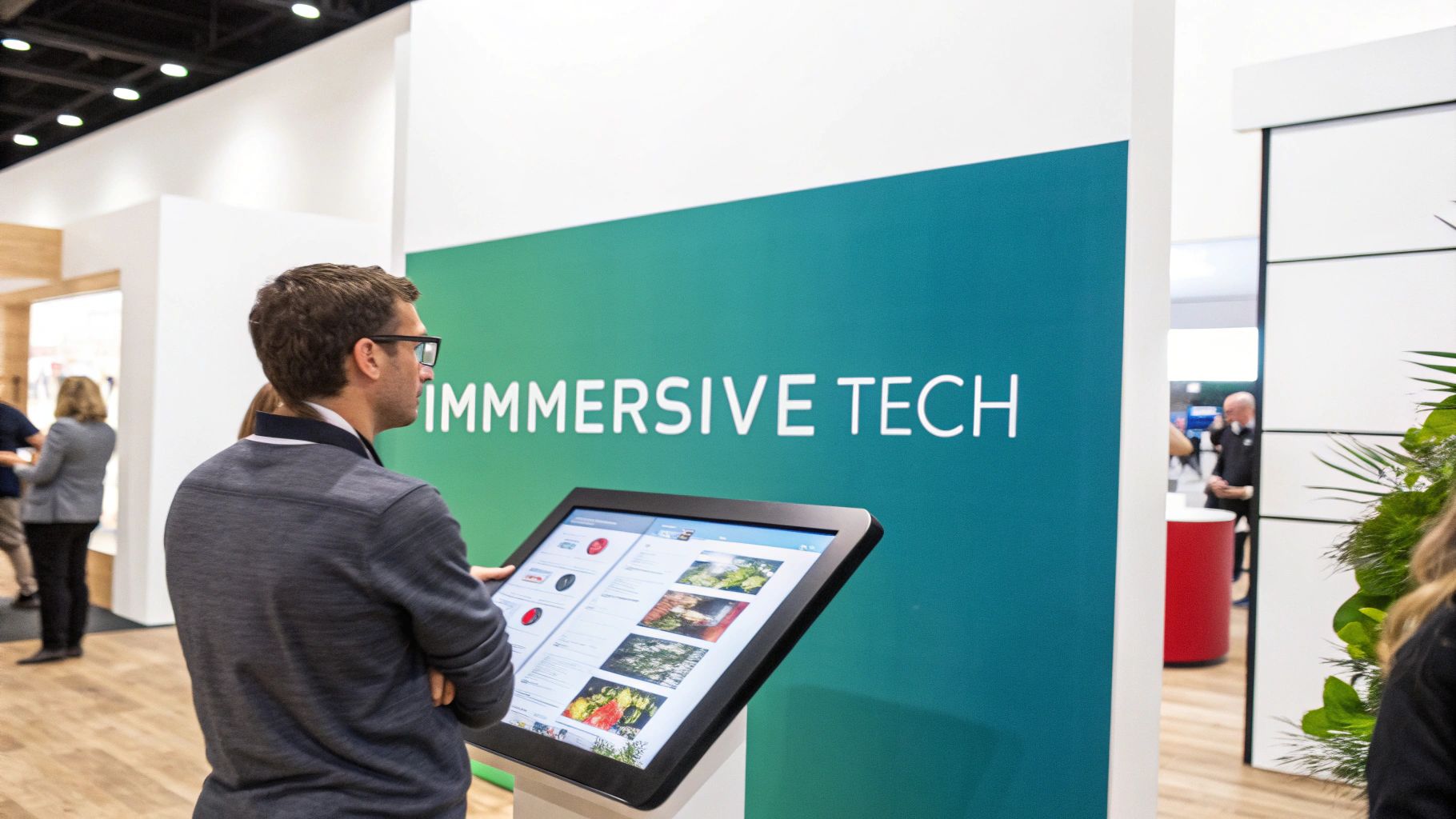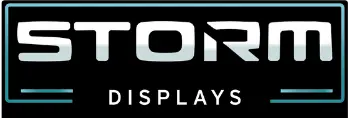Your conference booth is more than a backdrop; it's your brand’s physical address in a sea of competitors. You have a few precious seconds to capture an attendee's attention and spark a conversation that could lead to your next big client. So, how do you ensure your investment in conference booth displays translates into meaningful business results?
It all starts with a clear strategy. A beautiful booth without a purpose is just an expensive piece of art. The most effective displays are born from a deep understanding of specific goals, a target audience, and the practical realities of the event floor. This guide will walk you through the essential steps to transform your booth from a passive space into an active engagement hub.
Build Your Strategy Before You Build Your Booth
Everyone wants a show-stopping booth, but the most successful conference booth displays don't start with a design brief. They start with a solid strategy.
Jumping straight into choosing graphics and structures without a clear plan is a recipe for a beautiful but ineffective display. As a decision-maker, your first task is to define the "why" before you get to the "what." What is your primary objective for this specific show? The answer will shape every decision you make about your booth's design, layout, and messaging.
- Looking for leads? If your main goal is lead generation, your booth needs to be a well-oiled machine. This means clear, direct messaging, easy-to-use badge scanners, and a layout that guides people smoothly toward a sign-up or demo station. The entire experience must be quick and efficient.
- Boosting brand awareness? Maybe you just need to make a splash and get your name out there. In that case, go for bold, high-impact graphics that can be seen from across the hall. An open, inviting design with prominent branding will make you memorable.
- Launching a new product? If you’re unveiling something new, the product has to be the star. Your booth should be built around it, featuring dedicated demo areas, interactive screens, and signage that screams "this is new and you need to see it."
- Strengthening relationships? Sometimes, the goal isn't new business but nurturing existing connections. A booth designed for this might have semi-private meeting nooks, comfy seating, and maybe even a coffee bar to create a more relaxed, hospitality-focused vibe.
Know Your Audience and Your Budget
Once you’ve defined why you're there, you need to focus on who you're there for.
Put yourself in the shoes of your ideal attendee. What challenges are they trying to solve by walking this show floor? When you understand their pain points, you can craft messaging that resonates, making them feel like your booth was designed specifically for them. A deep dive into overall strategies for trade show success can offer valuable insights here.
Finally, let's talk money. You need a realistic budget that covers more than just the physical display. Factor in everything: shipping, drayage (the fee for moving materials from the dock to your spot), staffing, travel, and even branded giveaways.
It's a serious investment, but a worthwhile one. The US B2B trade show market hit around $15.8 billion in 2024, and it's still growing. What’s more, a staggering 95% of exhibitors say they prefer in-person events to virtual ones, proving just how powerful a physical presence is. You can read more about the resilience of the trade show market on shelftrend.com.
Aligning your goals with your audience's needs—all while staying within a clear budget—is the bedrock of a successful exhibit. Get this part right, and you're setting yourself up for a real return on your investment.
To help visualize how your goals translate into tangible features, here’s a quick breakdown.
Matching Booth Goals to Display Features
| Primary Goal | Key Display Feature | Engagement Tactic Example |
|---|---|---|
| Lead Generation | Integrated tech (badge scanners, tablets) | Host a 5-minute lightning demo every hour with a giveaway for attendees who get scanned. |
| Brand Awareness | Large-format, overhead signage & bold lighting | Create a highly "Instagrammable" photo-op area that encourages social sharing with a branded hashtag. |
| Product Launch | Hands-on, interactive demo stations | Allow attendees to use the new product themselves in a guided, real-world scenario. |
| Client Relationships | Semi-private, comfortable meeting space | Offer an exclusive "VIP lounge" with premium coffee for existing clients to relax and chat. |
This strategic alignment is what separates the booths that get a polite nod from the ones that get all the buzz and, more importantly, the business.
This foundational planning is a huge piece of the puzzle. For a deeper look at tying it all together, check out our complete guide on building a powerful trade show marketing strategy.
Choosing the Right Type of Booth for Your Brand
Stepping into the world of conference booth displays can feel overwhelming. You're faced with industry jargon, hardware options, and countless choices. However, the best decision always boils down to a few key factors: your brand identity, your event goals, and your budget.
The real question isn't just "what does it look like?" but "what job does it need to do?" Consider your specific situation. Will this booth travel with you to five shows this year? Does it need the flexibility to fit a 10×10 space one month and expand to a 10×20 the next? Or are you investing in a single, industry-defining event where you need to make an unforgettable splash? Your answers will point you in the right direction.
This decision tree is a great starting point to help you connect your goals with the type of hardware that will achieve them.

As you can see, your strategy—not just aesthetics—should drive this decision from day one.
Understanding Your Main Options
Let's get practical and break down the four main categories of conference booth displays. Each has its own strengths and is built for a different purpose.
- Custom Booths: This is the top of the line, designed and built from the ground up exclusively for your brand. A fully custom booth is your best bet when you need to dominate a major industry show and create a truly immersive brand experience. Nothing beats it for pure impact and a unique statement.
- Modular Displays: Think of these as a high-end set of building blocks. Modular systems use interchangeable parts that you can reconfigure to fit different booth sizes and layouts. This flexibility is a lifesaver for brands that attend multiple shows throughout the year, offering a great return on investment.
- Portable Displays: These are your grab-and-go solutions—lightweight, easy to carry, and simple to set up. We're talking pop-up backdrops and retractable banners. They're a fantastic choice for smaller budgets, first-time exhibitors, or when you just need a quick, professional presence.
- Rental Exhibits: Want a high-end look without the long-term commitment and cost? A trade show booth rental is the answer. It gives you access to an impressive, large-scale exhibit for a fraction of the cost of ownership, making it a smart move for companies testing a new market or avoiding the hassles of storage and maintenance.
The core question is this: Are you investing in a one-time "wow" moment or a long-term, versatile asset? Your answer will quickly narrow down the best path forward.
Scenarios and Solutions
To bring this all to life, let's walk through a few common scenarios.
Imagine a biotech company launching a game-changing medical device at their industry's biggest annual conference. Their single goal is to capture maximum media attention and investor interest. For them, a custom booth is the only real choice. It allows them to build a unique, controlled environment with dedicated demo stations, private meeting rooms, and dramatic lighting that tells a compelling story. A custom build screams "industry leader."
Now, consider a B2B software firm exhibiting at six regional trade shows a year. Their booth space changes constantly, from a standard 10×10 to a larger 10×20. A modular display is the no-brainer investment here. They can use a smaller configuration for local shows and add components for the big national conference, maintaining a consistent brand image while adapting on the fly.
Finally, think about a startup making its first appearance on the show floor. Their budget is tight and the team is small. The priority is simply to look professional and start conversations. A great portable display paired with a quality rental counter gives them a polished look without the logistical nightmare or heavy cost. It gets them in the game so they can focus on what really matters: connecting with attendees.
The debate between these systems can get pretty detailed. To dig a little deeper, you can check out our in-depth comparison of prefab vs. custom booths to see which approach is truly the right fit for your strategy. At the end of the day, every display type has its place; the smartest choice is the one that perfectly aligns with your goals, timeline, and finances.
Designing a Booth That Draws a Crowd
Great design is more than just aesthetics; it's a strategic weapon. On a chaotic conference floor, your booth’s design is the first and most important tool you have to stop a hurried attendee in their tracks and pull them into your world.
This process starts long before you send anything to print. It’s about crafting a visual story that someone can understand in three seconds from 30 feet away. The conference booths you remember from past shows likely used a powerful mix of bold visuals, smart lighting, and an intuitive layout that invited you to step inside.
Creating an Unmistakable Visual Presence
Your booth has to be seen from clear across the hall. The key here is visual hierarchy—guiding people’s eyes to the most important information first.
- Go high. Hanging signs or tall backdrops get your logo and key message up above the sea of heads. It's like a lighthouse guiding people straight to you.
- Be bold with your graphics. Forget walls of text. A single, massive, high-resolution image that showcases your product's benefit or sparks an emotion is infinitely more powerful. One great picture beats a dozen bullet points every single time.
- Light it up. Good lighting is a game-changer. It sets a mood, spotlights your hero products, and makes your graphics explode with color. Backlit fabric displays are fantastic for this—they create a modern, vibrant glow that really cuts through the dull convention center lighting.
This isn't just a gut feeling; the data backs it up. New research shows that 48% of exhibitors say that visually striking, eye-catching displays are the single most effective way to attract visitors.
Key Takeaway: Your goal is to make a powerful first impression before an attendee even thinks about stepping into your space. Your design needs to interrupt their journey down the aisle and spark enough curiosity to make them stop.
Crafting a Clear and Concise Message
Okay, you've grabbed their attention. Now you have about three seconds to tell them why they should care. The single biggest mistake exhibitors make is cramming too much text onto their graphics. People will simply tune it out and keep walking.
Your messaging needs to be dead simple. At the top, your brand name. Right below it, a tagline that immediately answers their silent question: "What's in it for me?"
For example, ditch the generic "Innovative Software Solutions." A much better message is "Automate Your Workflow in 10 Minutes." It’s specific, it’s benefit-driven, and they get it instantly. Save the details for your team to share or for an interactive kiosk inside the booth. The best trade show booth design perfectly marries stunning visuals with a message that hits home immediately.

Designing for Engagement and Flow
A fantastic design doesn't just attract people; it directs their experience once they're in your space. An open, logical layout makes people feel comfortable, encouraging them to stick around, explore, and actually talk to your team.
Whatever you do, avoid putting a long table across the front of your booth. It’s a physical and psychological barrier. Instead, create an open, welcoming entrance that invites people to step inside. Once they're in, guide them through different zones.
- Welcome Zone: Keep the front open and clear for initial greetings. This is where your team can quickly say hello and gauge interest.
- Demo Stations: Set up dedicated spots with monitors or products where your experts can give hands-on demonstrations.
- Meeting Nooks: Tuck some comfortable chairs and a small table into a quieter corner for serious conversations with hot leads or existing clients.
To really nail this, it helps to break down the key components of your design and what they're meant to achieve.
Key Design Elements for Maximum Impact
| Design Element | Purpose | Best Practice Tip |
|---|---|---|
| High-Level Branding | To make your booth visible from a distance and attract attendees from across the hall. | Use a hanging sign or a tall tower structure. Keep it simple: just your logo and maybe a core tagline. |
| Primary Messaging | To communicate your value proposition in under 3 seconds. | Place this at eye level. Focus on a benefit-driven headline, not a list of features. |
| Strategic Lighting | To create ambiance, highlight products, and make your graphics stand out. | Use spotlights on key products and backlit graphics for a modern, high-end feel. Avoid harsh, flat lighting. |
| Open Layout | To remove barriers and encourage attendees to enter your space freely. | Avoid placing a table across the front. Create a clear path that invites people in. |
| Interactive Displays | To engage visitors actively and let them experience your product or service firsthand. | Touchscreens, product demos, or even a simple quiz can draw people in and keep them there longer. |
Thinking through these elements turns your booth from a static ad into an interactive brand destination. You create a natural flow for visitors, guiding them from initial curiosity to a meaningful conversation. That’s how you ensure your investment pays off with memorable interactions and real, measurable results.
Integrating Technology For An Immersive Experience
In a crowded exhibit hall, a static conference booth display is no longer enough. Attendees are looking for engaging experiences, not just passive information. When used thoughtfully, technology can be the bridge that transforms your booth from a simple backdrop into an immersive brand destination.
Technology has the power to turn a passive setup into a hub of activity. Strategically placed screens, interactive stations, and augmented reality demos invite visitors to linger, explore, and connect with your message on a deeper level. It’s not about showcasing gadgets; it’s about weaving them into a compelling narrative.

Interest in “trade show displays” shot up by a whopping 317% over just a few months—a clear sign that exhibitors are seeking more dynamic solutions. They are crafting experiences that blend the physical and digital, telling richer stories and keeping attendees engaged. To dive deeper, check out the full trade show booth trends on Accio.
Tech That Engages And Informs
The best technology solutions guide visitors through your brand story seamlessly. Focus on creating an intuitive and valuable journey.
• Interactive Touchscreens
Turn your display into a self-guided tour. Visitors can browse product specs, watch quick case studies, or even configure custom options. This empowers attendees while freeing up your staff to focus on high-value conversations.
• Large-Scale Video Walls
A sprawling, high-def screen draws eyes from across the hall. Loop a concise brand video or highlight customer success stories. The combination of movement and scale holds attention like nothing else.
• Augmented Reality (AR) Demos
If your product is too large or complex to ship, AR is a game-changer. Let attendees project a 3D model onto the floor through a tablet, allowing them to explore features up close. It’s memorable, interactive, and solves a major logistical challenge.
The most successful tech feels invisible. Attendees should focus on the story and the takeaway, not on figuring out how the device works.
The Practical Side Of Tech Integration
Great ideas only succeed when the logistics are sound. Before you commit to video walls or AR stations, map out the behind-the-scenes details.
• Power Needs
High-resolution screens and multiple touch stations consume significant energy. Always order more amperage than you think you need to avoid a blown fuse during peak show hours.
• Internet Reliability
Never rely on the venue’s complimentary Wi-Fi for mission-critical demos. A dedicated, hard-wired connection—or a reliable 4G/5G hotspot—is essential to keep your apps and lead capture tools running smoothly.
• User-Friendly Operation
Your on-site team won’t have time for a complicated crash course. Choose tech with an intuitive interface that any team member can master quickly, and conduct practice sessions before the show opens.
Pulling these elements together creates a booth that feels effortless and engaging. Consider exhibits designed around technology from the ground up—like backlit trade show displays that make your graphics pop and seamlessly hide cables for a clean, professional look. The result? A cohesive space where digital and physical storytelling work in perfect harmony.
Ready to create a conference booth that turns heads and drives real business results? The team at Storm Displays lives and breathes this stuff. We can guide you through every step, from the first sketch to the final installation.
Request a quote today and let's start building your next success story.

